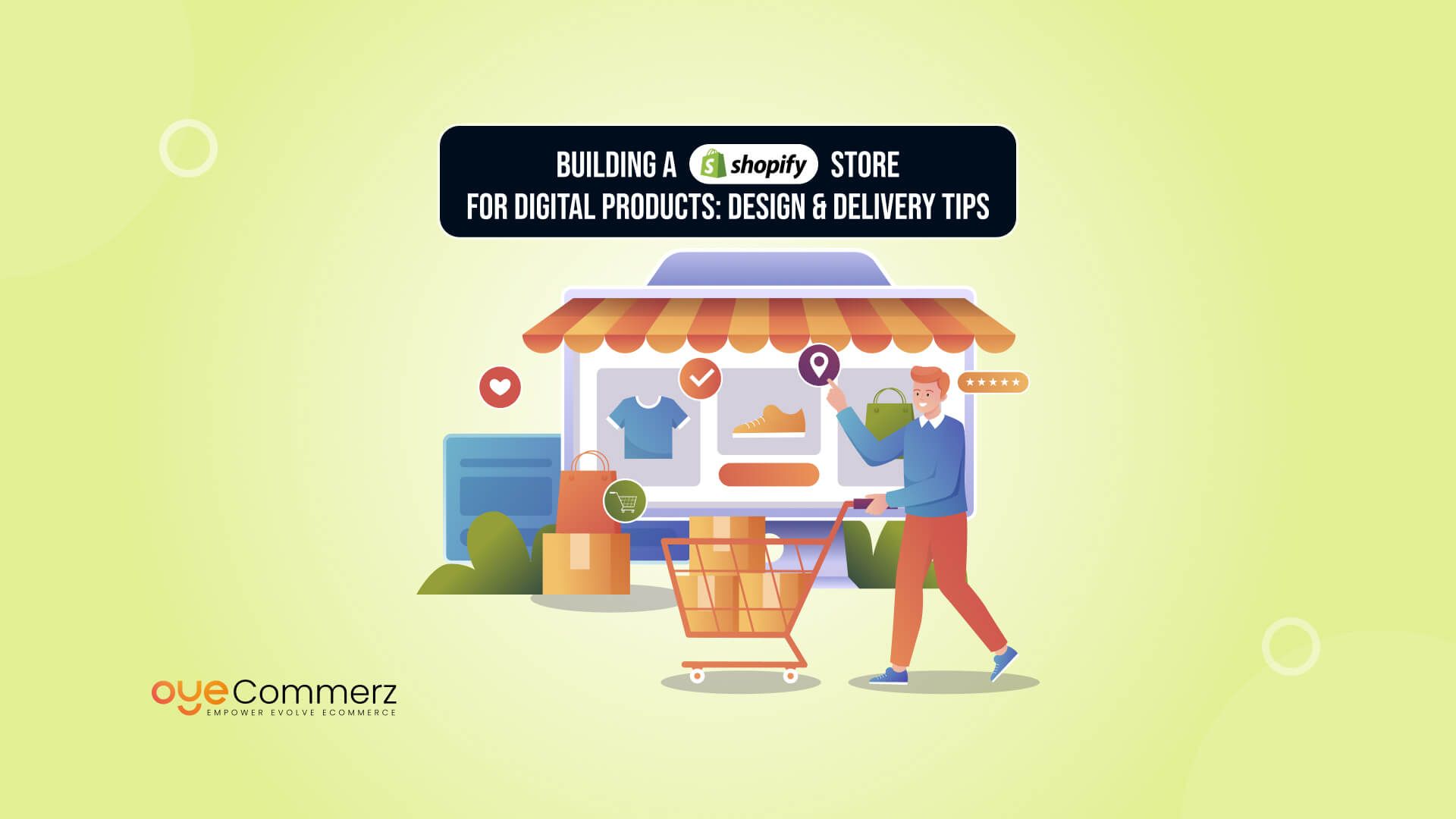Did you know the digital products market is projected to surpass $500 billion by 2027? Whether it’s eBooks, online courses, templates, software, or music, digital goods are becoming one of the most profitable and scalable ways to sell online. With no inventory to manage or shipping logistics to handle, creators and entrepreneurs can focus on building high-value content and automating delivery. Shopify stands out as a powerful platform for digital product businesses; it’s user-friendly, supports secure downloads, integrates with delivery apps, and offers complete control over design and branding.
In this guide, we’ll walk you through everything you need to know: from setting up your Shopify store and choosing the right tools, to designing product pages, delivering files efficiently, and optimizing the customer experience for long-term success.
Table of Contents
ToggleWhy Sell Digital Products on Shopify?
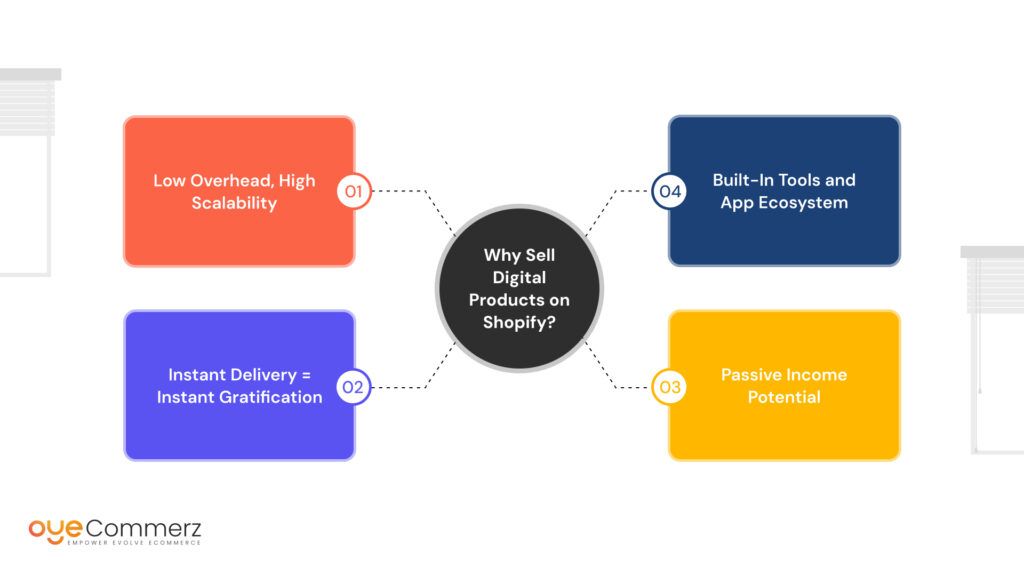
Selling digital products like eBooks, online courses, design templates, music, or software has become an increasingly popular way to generate revenue online. Shopify, primarily known for physical goods, is also a powerful platform for digital product sellers. Here’s why:
1. Low Overhead, High Scalability
Unlike physical inventory, digital products don’t require manufacturing, packaging, or shipping. That means:
- No storage costs
- No shipping logistics
- No inventory management hassles
This low barrier to entry allows creators and entrepreneurs to start with minimal capital and scale quickly as sales grow.
2. Instant Delivery = Instant Gratification
With Shopify, customers can receive their digital product immediately after purchase via automated email or download links. This fast fulfillment:
- Increases customer satisfaction
- Reduces support inquiries
- Encourages repeat purchases
Apps like Digital Downloads, SendOwl, and Sky Pilot integrate seamlessly to automate the delivery process.
3. Passive Income Potential
Once your product is created and your store is set up, you can generate revenue 24/7 without additional effort. You can:
- Sell the same product repeatedly with no extra cost
- Bundle digital products for upsells
- Use automated marketing flows to drive continuous sales
4. Built-In Tools and App Ecosystem
Shopify offers a rich ecosystem to support digital product sellers:
- App integrations like FetchApp, Easy Digital Products, and Courses Plus
- Built-in analytics to monitor performance and buyer behavior
- SEO and blog tools to drive organic traffic
- Email marketing integrations like Klaviyo and Omnisend to nurture leads
You also get access to Shopify’s high-converting themes, secure payment processing, and scalable hosting all without needing custom development.
Shopify vs. Other Digital Product Platforms
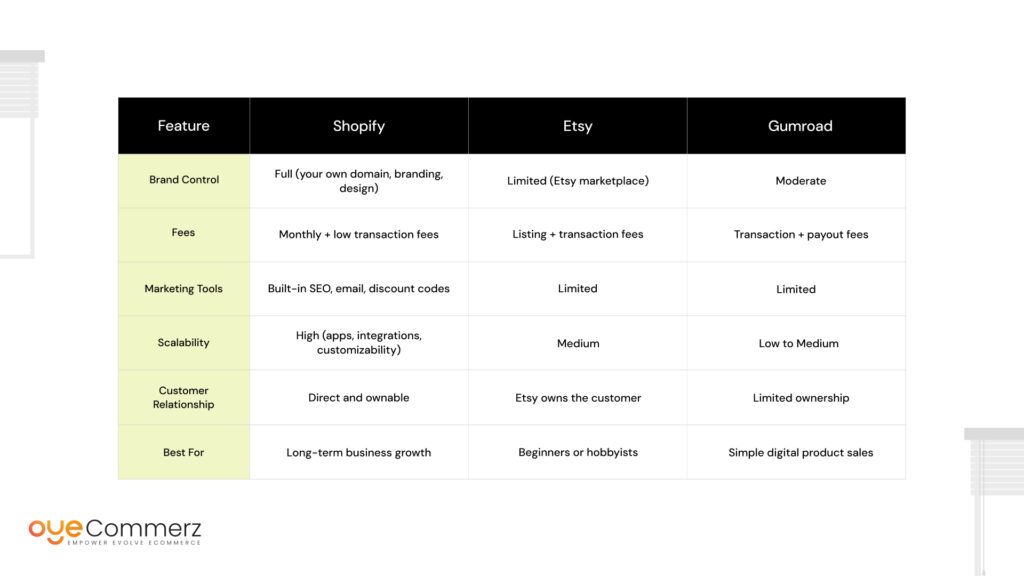
Verdict: While platforms like Etsy and Gumroad are great for getting started, Shopify is better suited for serious sellers who want to scale, own their audience, and build a brand
Setting Up a Shopify Store for Digital Products
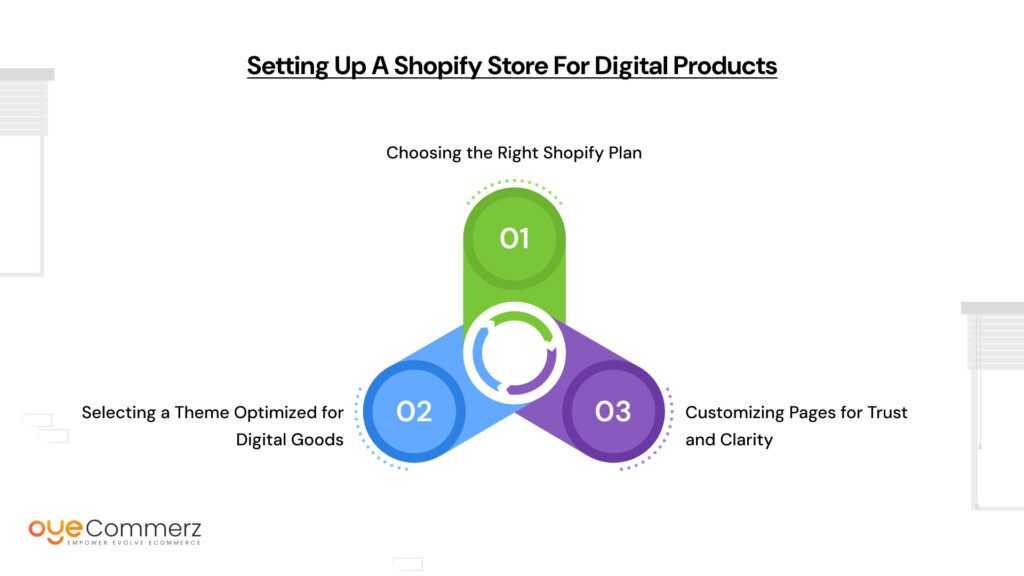
Selling digital products on Shopify starts with a few strategic setup decisions. From selecting the right plan to designing a high-converting storefront, here’s how to build a digital product store that inspires trust and drives sales.
1. Choosing the Right Shopify Plan
For most digital product sellers, the Basic Shopify plan is more than enough to get started. It includes:
- Your own domain
- Secure checkout
- Access to essential apps
- Built-in marketing tools
- Unlimited digital product listings
Tip: If you’re scaling or need advanced reporting, consider the Shopify or Advanced Shopify plans later on.
You don’t need features like inventory management or shipping settings so your focus can stay on content, not logistics.
2. Selecting a Theme Optimized for Digital Goods
Because digital product stores don’t rely on visuals like product packaging or physical displays, your theme should prioritize simplicity, speed, and clarity.
Look for themes that are:
- Clean and minimal: Avoid clutter that distracts from your content
- Fast-loading: Speed matters for conversion, especially on mobile
- Optimized for storytelling: A good digital product store needs room for descriptions, benefits, testimonials, and visual previews
Recommended Shopify Themes for Digital Products:
- Startup – Great for single or limited product lines
- Narrative – Ideal for storytelling-focused sales pages
- Baseline (free theme) – Sleek, modern, and highly customizable
Customize your homepage to highlight bestsellers, customer reviews, and product benefits rather than a catalog-style layout.
3. Customizing Pages for Trust and Clarity
Digital products come with unique concerns like download issues or refund policies. Build confidence and clarity with well-written static pages:
About Page
Tell your story. Why are you creating these products? What’s your expertise or passion? This helps personalize the experience and builds brand trust.
FAQ Page
Answer common questions about:
- File formats
- How downloads work
- Licensing or usage rights
- Support availability
Refund Policy
Be crystal clear. Digital products are often non-refundable, so state your policy upfront to reduce disputes:
“Due to the nature of digital goods, all sales are final. If you experience any issues with your file, please contact us and we’ll make it right.”
Contact Page
Add an easy way for customers to reach you with questions. This reduces hesitation and builds credibility.
Bonus: Add Trust Badges, secure payment icons, and testimonials across your product pages to boost conversion rates.
Designing for Conversion and Clarity
When selling digital products on Shopify, design plays a critical role in turning visitors into buyers. A well-structured store helps users quickly understand your offer, trust your brand, and make confident purchases. Here’s how to optimize your homepage, product pages, and calls-to-action for maximum conversion.
1. Homepage Tips: Lead With Benefits
Your homepage should clearly communicate the value of your digital products. Instead of showcasing every item, focus on why your products matter and who they’re for.
Key elements to include:
- A compelling headline that highlights the transformation or benefit your product offers.
- Short, benefit-driven sections that speak directly to your audience’s needs.
- Clear product categories or bundles to help users browse efficiently (e.g., Templates, Online Courses, Ebooks).
- Best-selling or featured products to guide decision-making.
- Customer testimonials to build trust and credibility.
Think of your homepage as a landing page every section should move visitors closer to purchasing.
2. Product Page Essentials
Your product page is where the decision to buy happens. It should inform, persuade, and reassure the buyer with zero confusion.
Make sure you include:
- Clear, benefit-oriented descriptions
Explain what the product is, who it’s for, and what problems it solves. Use bullet points to make key features and outcomes easy to scan. - Visual or interactive previews
Let users see what they’re getting. Include:
- Sample chapters for ebooks or guides
- Demo videos for courses or software
- Screenshots or mockups for templates and design assets
- Social proof
Incorporate testimonials, user reviews, or case studies. Real feedback reassures new customers and adds legitimacy to your offer.
3. Using Strong CTAs and Trust Signals
Your calls-to-action (CTAs) and trust-building elements help reduce hesitation and improve conversions.
Best practices for CTAs:
- Use action-driven language like “Download Now,” “Start Learning,” or “Buy and Access Instantly.”
- Make your buttons stand out visually and place them in multiple locations on the page (especially above the fold and near the bottom).
- Ensure the purchase process is smooth and distraction-free.
Add trust signals wherever appropriate:
- Secure checkout and payment badges
- A clear, easy-to-find refund policy (especially important for digital goods)
- Money-back guarantees (if applicable)
- Customer support details or FAQs
When visitors feel safe, informed, and confident, they’re much more likely to convert.
Managing and Delivering Digital Products
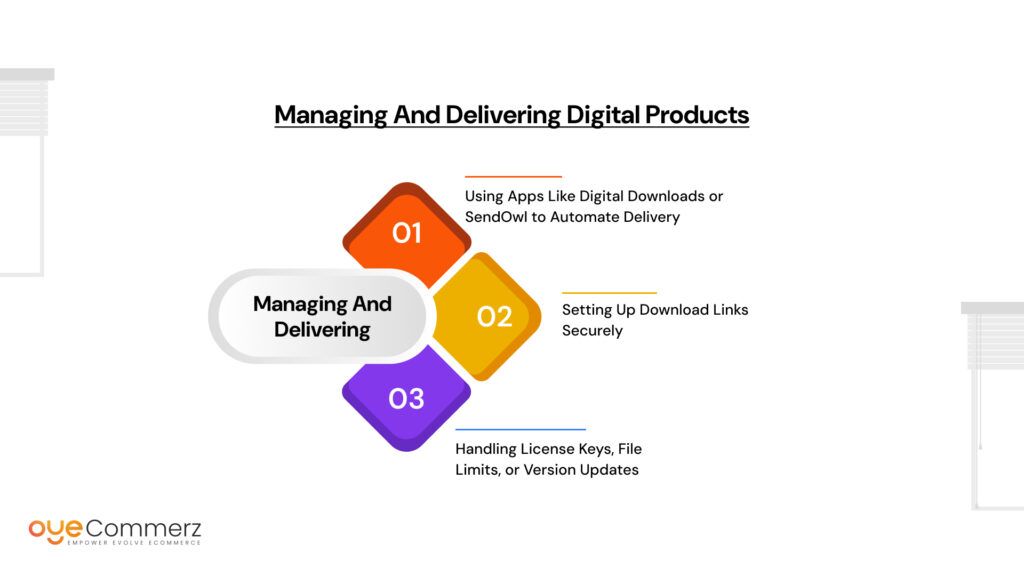
Once your Shopify store is set up and your products are listed, the next step is ensuring smooth, automated delivery and managing updates, licenses, and file access. This section covers how to streamline these processes using Shopify apps and best practices.
1. Using Apps Like Digital Downloads or SendOwl to Automate Delivery
The key to a successful digital product business is efficient, hands-off delivery. Fortunately, Shopify provides several apps to automate the entire process, ensuring that customers receive their files instantly after purchase.
Recommended Apps for Digital Delivery:
- Digital Downloads (Free)
This app is perfect for basic digital product stores. It allows you to attach files to products and automatically sends the download link to customers upon purchase. - SendOwl (Paid)
For more advanced features, such as automated email reminders, subscription-based digital products, or license key management, SendOwl is a great option. It also includes built-in tracking for digital product sales. - Sky Pilot (Paid)
If you need to sell large files (videos, software packages, etc.), Sky Pilot allows you to deliver files securely, and it integrates seamlessly with your Shopify store.
These apps automate the process from purchase to delivery, ensuring your customers receive their files quickly and reducing manual labor.
2. Setting Up Download Links Securely
Security is critical when delivering digital products, especially for high-value items or those with licensing concerns.
To secure your download links:
- Limit access
Only allow access to the download link for a set amount of time (e.g., 24-48 hours) or after a specific number of downloads to prevent unauthorized sharing. - Password-protected downloads
For products like online courses or exclusive content, consider using password protection or personalized download links that are unique to each buyer. - Use encrypted links
Ensure that your digital delivery apps encrypt links, preventing unauthorized users from accessing the content.
Tip: Apps like SendOwl offer customizable download expiration times and download limits to further protect your files.
3. Handling License Keys, File Limits, or Version Updates
For products like software, templates, or other items that require updates, it’s essential to manage licenses, version control, and product limitations effectively.
License Key Management:
- Use apps like SendOwl or Keygen to automatically generate and deliver license keys to customers after purchase. This ensures only authorized users can access the product.
- Provide clear instructions on how to enter and activate the product, and allow for easy license renewal or transfer options if necessary.
File Limits and Version Updates:
- For software or templates, keep customers informed about any updates or changes.
- Send automatic email notifications when a new version is released.
- Use the Digital Downloads app to replace old files with new versions (without needing to change the product page).
- If you’re offering a service with file limitations (like a template with limited licenses), ensure that your download links or customer dashboard reflects these restrictions clearly.
Ensure that version updates are easy to access and that the process for receiving the update (e.g., re-downloading) is clear for customers
Optimizing Checkout and Customer Experience
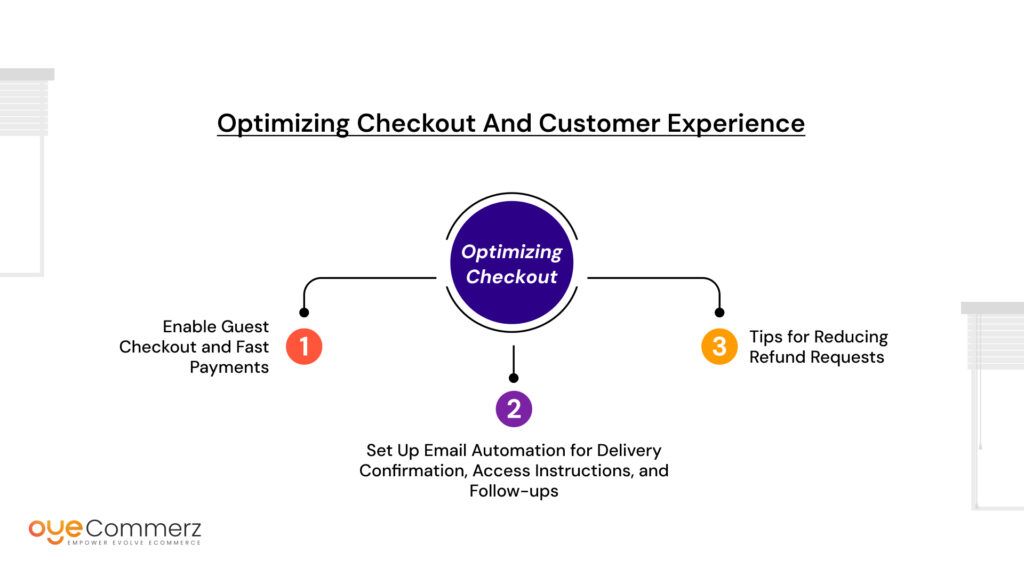
An optimized checkout process and a seamless post-purchase experience can significantly boost your digital product sales. Reducing friction, automating communication, and ensuring clear expectations are key to building trust and satisfaction with your customers.
1. Enable Guest Checkout and Fast Payments
Making the checkout process as quick and easy as possible is essential to reducing cart abandonment and increasing conversion rates.
Key strategies:
- Enable guest checkout
Not everyone wants to create an account before purchasing. Allowing customers to check out as guests helps streamline the process and lowers friction. - Offer multiple payment options
Provide various payment methods, such as Shopify Payments, PayPal, Apple Pay, and Google Pay. The more options available, the less likely a potential customer will drop off due to limited choices. - Streamline the checkout process
Reduce the number of steps to complete a purchase. Keep forms short, and ensure your payment page is mobile-friendly. Aim for a seamless experience, especially for digital goods, where speed is crucial.
Pro Tip: Enabling one-click checkout options, like Shopify Pay, can dramatically speed up the purchasing process and increase conversions.
2. Set Up Email Automation for Delivery Confirmation, Access Instructions, and Follow-ups
Post-purchase communication is critical for a smooth customer experience. Automation tools can ensure that your customers get the information they need without delays or confusion.
Essential email automations:
- Delivery confirmation
As soon as a customer makes a purchase, trigger an email confirming their order and providing the download link or access details. - Access instructions
Include clear instructions on how to access the product, download files, or use the product (e.g., how to install software or access an online course). - Follow-up emails
- Reminder email (if the product has a time-sensitive offer or limited access)
- Product usage tips or helpful resources to encourage product engagement
- Review request or feedback survey to improve your offerings
Apps like Klaviyo, Omnisend, or Shopify’s built-in email marketing feature can help automate these processes effectively.
Tip: Include an “Add to Contacts” recommendation in your emails to ensure delivery and reduce the chances of being flagged as spam.
3. Tips for Reducing Refund Requests
One of the challenges of selling digital products is handling refund requests, especially when the customer feels unsatisfied. Here are a few tips to reduce these requests:
Set Clear Expectations:
- Product descriptions should be detailed and transparent, including information about what the customer will receive (e.g., file formats, size, license terms).
- Clearly state your refund policy on the product page, checkout page, and in post-purchase emails. Make sure your policy aligns with your business practices and the nature of digital goods (e.g., “All sales are final for digital downloads”).
Use Sample Previews:
- Offer free previews of your digital products (e.g., sample chapters, demo videos, or templates). This allows customers to assess the quality and suitability before purchasing.
- Use images or videos to give potential buyers a clear understanding of what they’re buying. Showing a real-world example can reduce doubts.
Communication is Key:
- Ensure customer support is easily accessible via email, chat, or a help center to address issues promptly.
- Provide a clear process for handling issues or problems, such as broken links or corrupted files, with immediate solutions.
Pro Tip: If a refund request is submitted, respond quickly and offer a resolution, whether it’s a replacement file or a credit toward future purchases, to avoid negative customer experiences.
Contact to Migrate your Site to Shopify Now
Marketing Your Digital Products
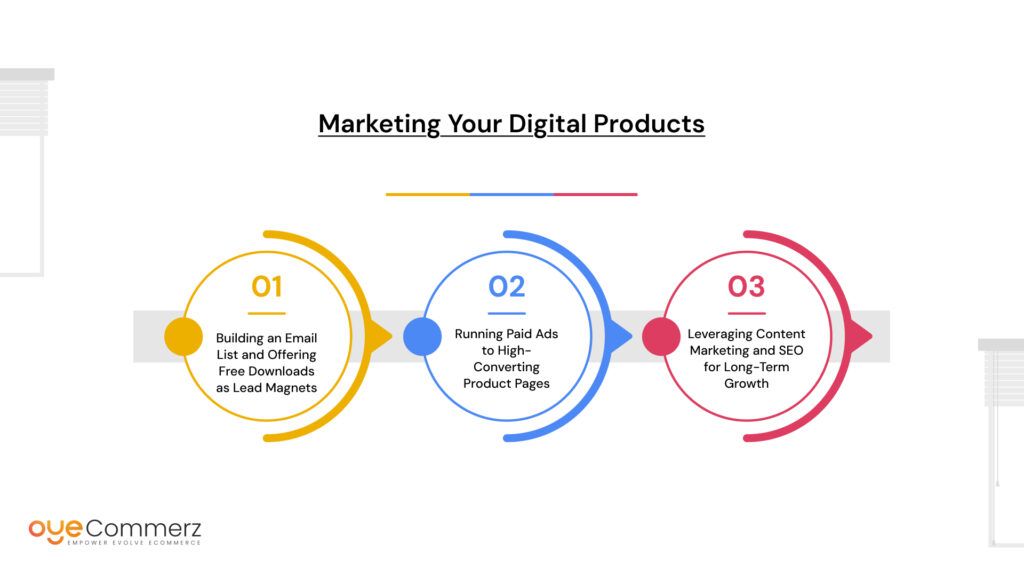
Promoting your digital products effectively is essential to drive traffic, convert visitors, and build long-term customer relationships. From leveraging email marketing to paid ads and content strategies, here’s how to get your products in front of the right audience.
1. Building an Email List and Offering Free Downloads as Lead Magnets
Email marketing is one of the most powerful tools to nurture relationships with your customers and encourage repeat purchases.
How to get started:
- Create lead magnets
Offer a high-value, free digital product (e.g., an eBook, checklist, or free template) in exchange for visitors’ email addresses. This helps you build your email list quickly. - Optimize your sign-up forms
Place sign-up forms in prominent locations on your site (homepage, blog posts, product pages) to make it easy for visitors to subscribe. - Use pop-ups or sticky bars
Tools like Privy or OptinMonster can create non-intrusive pop-ups that offer your free download in exchange for an email address.
Once you’ve built an email list, use it to:
- Send welcome emails with the promised lead magnet
- Nurture relationships with helpful content
- Promote paid products or limited-time offers
Pro Tip: Use email automation to nurture your leads by sending them a sequence of emails that gradually introduce them to your paid products.
2. Running Paid Ads to High-Converting Product Pages
Paid advertising is a great way to drive targeted traffic directly to your high-converting product pages.
Where to run ads:
- Facebook & Instagram Ads
These platforms allow for highly targeted ads, where you can reach specific demographics and interests. If you’re selling a visual product (e.g., design templates, photography), these platforms are ideal. - Google Ads
Run search ads targeting specific keywords related to your product. Google’s search intent makes it a great platform to convert users actively searching for a solution you provide. - Pinterest Ads
If your digital products have a strong visual element, consider Pinterest, especially for design assets, printables, or courses. Pinterest ads work well for driving traffic to your product pages.
Best practices:
- Always send traffic to high-converting landing pages or product pages, not your homepage. This keeps the experience focused and reduces bounce rates.
- Use retargeting ads to bring back visitors who didn’t convert the first time.
Tip: Split test your ads to find the best copy, visuals, and audience segments to optimize your ROI.
3. Leveraging Content Marketing and SEO for Long-Term Growth
Content marketing is essential for creating lasting value and driving organic traffic over time. By ranking your content on search engines, you can continue to drive sales without the ongoing costs of paid ads.
Key strategies:
- Start a blog
Create valuable blog content related to your digital products. For example, if you sell productivity planners, you could write articles about “How to Stay Organized in 2025” or “Top 10 Digital Tools for Entrepreneurs.” - Optimize for SEO
Do thorough keyword research using tools like Ahrefs or SEMrush to understand what potential customers are searching for. Incorporate these keywords into your blog posts, product descriptions, and landing pages. - Create long-form content
Invest in creating comprehensive guides or resources around your niche. These can rank higher in search results and provide a rich resource for visitors. Long-form content builds authority and trust. - Repurpose content
Repurpose blog posts into different formats videos, social media posts, downloadable guides, or webinars. This increases the reach of your content and helps bring in different types of traffic. - Leverage guest posts and backlinks
Write guest posts for other relevant blogs in your industry and include a link to your product page. This builds backlinks and increases your domain authority, leading to higher search rankings.
Pro Tip: Consistently updating old content and optimizing for new keywords can boost your SEO performance over time.
Ready to Launch or Refine Your Digital Product Store?
If you’re ready to take the next step in launching or refining your digital product store, Oyecommerz is here to help. Our team specializes in Shopify store setup, custom design, and growth strategies to ensure your success.
Need expert help launching your digital Shopify store?
Contact Oyecommerz today for personalized support and solutions that will elevate your digital product business.
Conclusion
Selling digital products on Shopify offers a great opportunity to build a successful online business with low overhead and high potential for passive income. By carefully planning your product offerings, designing a user-friendly store, automating delivery, and implementing effective marketing strategies, you can create an efficient and profitable digital product business. Follow these key steps, and you’ll be on your way to growing your online presence and reaching customers around the world.
Frequently Asked Questions
To design a digital product store, focus on clean layouts, fast loading times, and highlighting key product benefits. Use Shopify themes like “Streamline” or “Minimal” that prioritize readability and simplicity. Avoid elements meant for physical products (like shipping details) and instead emphasize instant download access and compatibility.
Use apps like Shopify Digital Downloads (free) or SendOwl, Sky Pilot, or FetchApp for automated and secure delivery. These apps allow you to attach files to products, limit download attempts, and send auto emails with download links.
Use delivery tools with license key generation, PDF stamping, or expiring download links. Consider tools like SendOwl for license keys or PDF Stamping via Sky Pilot or third-party integrations. Hosting files off-site (e.g., Amazon S3) adds an extra layer of control.
Use mockups or visual previews, demo videos, testimonials, and feature lists. Add FAQ sections, clear refund policies, and offer limited-time bundles or upsells to increase conversions. Consider integrating email marketing (e.g., Klaviyo) and SEO apps to attract organic traffic.
Yes. Use apps like Bold Subscriptions, PayWhirl, or Recharge to sell recurring memberships, course access, or content packs. Combine with content restriction tools (e.g., Locksmith) or learning platforms like Thinkific (Shopify-integrated) for gated content delivery.

